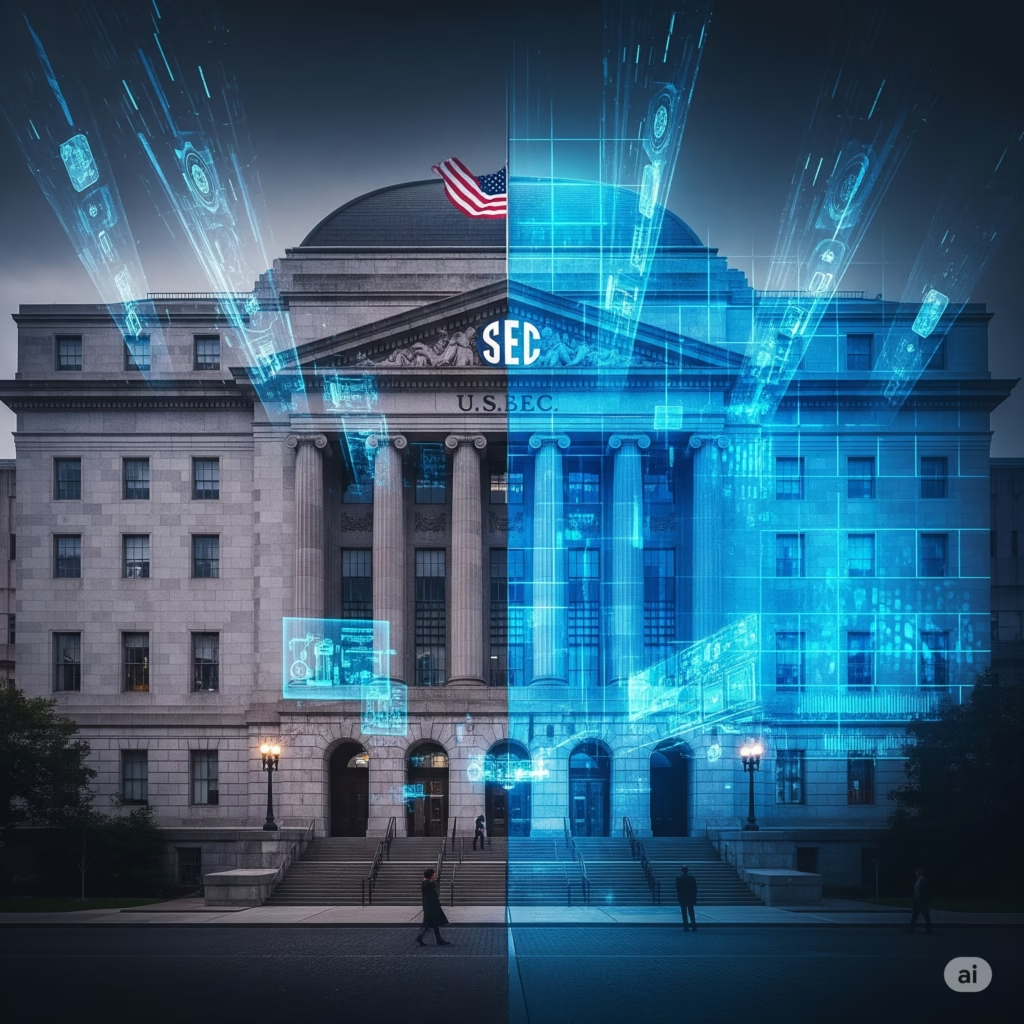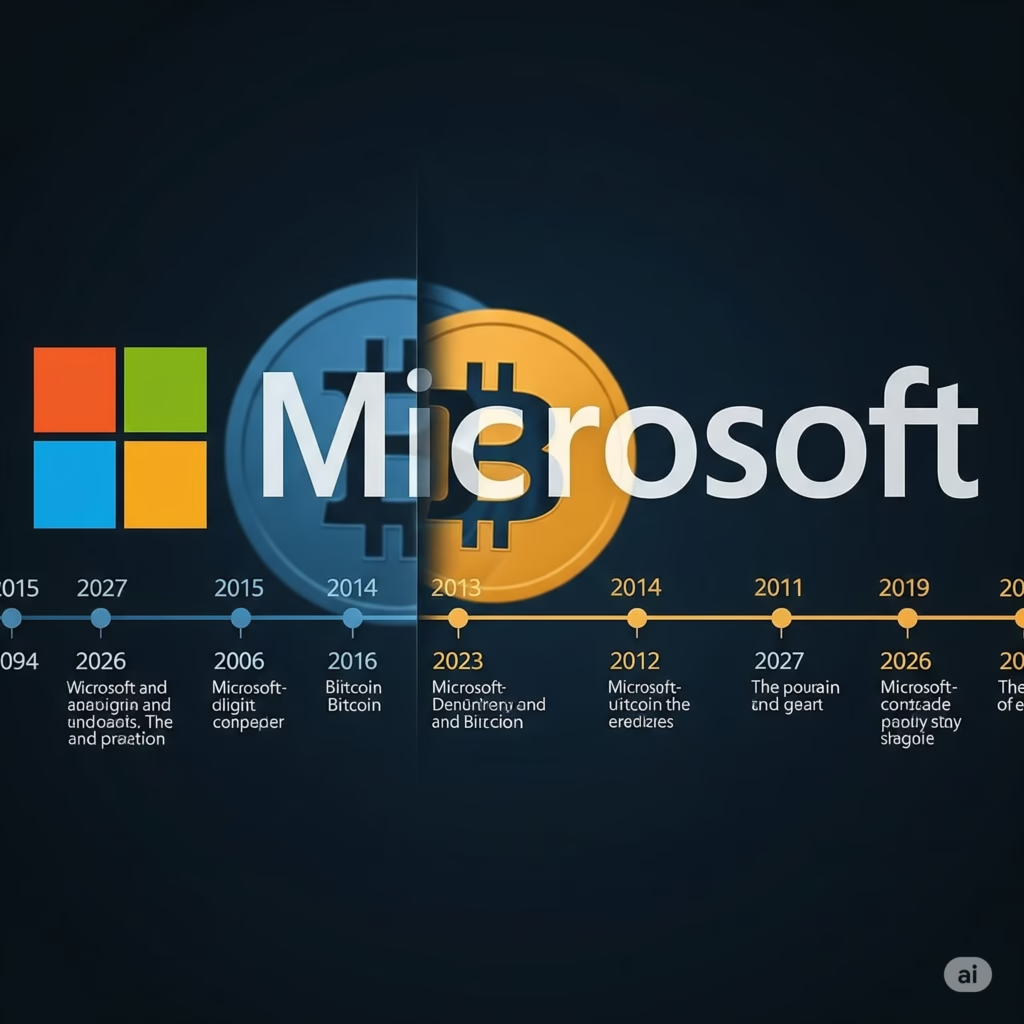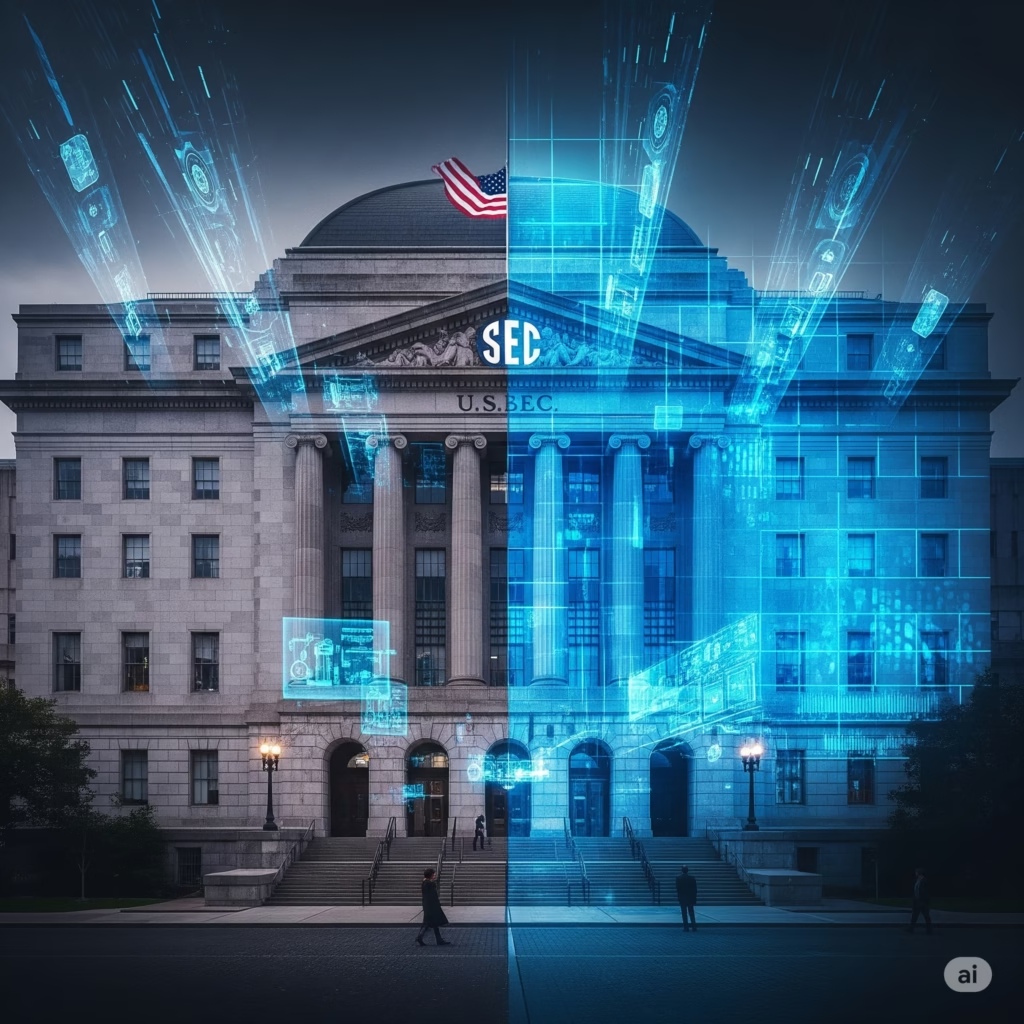
Table of Contents
✅ SEC Policy Reversal and the New Era of Crypto Custody

The U.S. Securities and Exchange Commission (SEC) has recently made a groundbreaking move that could reshape the future of crypto and traditional banking: a reversal of the controversial Staff Accounting Bulletin No. 121 (SAB 121). This shift, formally represented in the newly proposed SAB 122, aims to open doors for regulated banks to enter the crypto custody business without facing crushing capital constraints.
🔍 What Was SAB 121?
Issued in March 2022, SAB 121 required banks and public companies holding crypto on behalf of clients to list the crypto as liabilities on their own balance sheets, paired with a matching asset. This accounting method created significant financial disincentives, deterring banks from providing custodial crypto services. Experts and institutions flagged it as a barrier to innovation and institutional crypto adoption.
“SAB 121 imposed punitive accounting that treated custody like ownership, creating friction in a sector that thrives on trust.”
— Paul Grewal, Chief Legal Officer, Coinbase
🔁 The Game-Changer: SEC Reverses Stance with SAB 122
Under increasing pressure from Congress, the banking sector, and crypto innovators, the SEC reversed its earlier guidance with SAB 122. This new policy no longer mandates crypto custodians to reflect held assets on their balance sheets—removing a major obstacle and aligning with traditional custodial accounting standards.
Key catalysts for this reversal include:
- Bipartisan political pushback against anti-crypto bias.
- Extensive lobbying by the American Bankers Association.
- Legal concerns about overstepping the SEC’s accounting authority.
This landmark move is seen as a pro-innovation signal from the SEC and has energized U.S. financial institutions eyeing the growing digital asset sector.
🌐 Why It Matters Now
- Crypto market cap in 2025 is poised to exceed $2.5 trillion, with rising institutional interest in safe and compliant asset storage.
- Stablecoin usage and tokenized real-world assets (RWAs) are on the rise, requiring credible custody infrastructure.
- The U.S. lags behind countries like Switzerland and Singapore in enabling regulated crypto banking services.
With the new policy, major banks can now tap into a booming market, bridging the gap between crypto-native platforms and legacy finance.
🧠 Expert Quote
“The SEC’s reversal marks a foundational pivot—paving the way for mainstream adoption of digital assets within the traditional banking ecosystem.”
— Nic Carter, Partner, Castle Island Ventures
✅ Key Changes Introduced by SAB 122 – A Regulatory Turning Point

The shift from SAB 121 to SAB 122 marks a pivotal regulatory evolution, specifically tailored to accommodate the banking industry’s entry into the crypto custody market.
Below, we break down the core differences between the two guidelines and how these changes dramatically improve the compliance and feasibility landscape for banks.
🔄 SAB 121 vs SAB 122 – What’s Changed?
| Aspect | SAB 121 (Old) | SAB 122 (New) |
|---|---|---|
| Balance Sheet Impact | Required crypto holdings to be listed as both liabilities and assets on banks’ balance sheets | Custodied crypto is no longer required to be reported on the balance sheet |
| Capital Requirements | Significantly increased capital burdens due to asset-liability treatment | Restores traditional custodial accounting; no excessive capital provisioning |
| Custody Feasibility | Discouraged banks from entering crypto custody markets | Encourages banking institutions to offer crypto custodial services |
| Legal & Regulatory Standing | Criticized for being a staff interpretation, not official SEC rule | Improved transparency and stakeholder consultation; likely to pass formal review |
| Market Reaction | Backlash from banks, lawmakers, and crypto firms | Welcomed as a progressive step toward Web3 financial integration |
📊 What This Means for the Industry
- Banks can now build crypto infrastructure without risking financial instability due to skewed balance sheet optics.
- Investors gain confidence knowing their assets are held under robust, regulated custody.
- Fintech firms may now partner with traditional banks, allowing seamless crypto-fiat interoperability.
🧠 Expert Insight
“This isn’t just about accounting—it’s about unlocking a new asset class for the traditional financial system.”
— Michael Saylor, Executive Chairman, MicroStrategy
✅ Why Banks Are Now Rushing Into Crypto Custody

The reversal of SAB 121 via the introduction of SAB 122 has removed the biggest regulatory bottleneck holding banks back from entering the crypto custody space. With the balance sheet burden lifted, financial institutions now see a lucrative opportunity to serve a booming market with untapped potential.
🏦 Strategic Incentives Driving Bank Adoption
Here are the key reasons why major global banks are accelerating crypto custody rollouts:
1. Institutional Demand
- Hedge funds, pension funds, and family offices want secure, regulated custody solutions.
- Traditional banks offer established trust and security frameworks that crypto-native firms can’t always match.
“Our clients are asking for it, so we’re building the infrastructure to serve them.”
— Larry Fink, CEO of BlackRock
2. New Revenue Streams
- Banks can charge custody fees, transaction spreads, and access premiums.
- Crypto custody acts as a gateway to offer DeFi access, staking services, and tokenized assets.
3. Regulatory Clarity Boosts Confidence
- With SAB 122 offering accounting clarity, compliance departments can now greenlight custodial services.
- FDIC-insured institutions now view crypto as less of a liability and more of an asset opportunity.
📈 Major Players Already in the Game (2025 Snapshot)
| Bank Name | Crypto Custody Status | Additional Services |
|---|---|---|
| JPMorgan Chase | Active (Since Q1 2025) | Tokenized deposits, On-chain compliance |
| BNY Mellon | Active | Crypto fund services |
| Standard Chartered | Expansion underway | Cross-border settlement |
| Citibank | Testing phase | Stablecoin custody |
| Deutsche Bank | Launched pilot custody | Digital bond storage |
🌐 Global Ripple Effects
- Europe: Banks in Germany, Switzerland, and the UK are ramping up digital asset custody offerings under MiCA compliance.
- Asia: Japanese and Korean banks see this as a chance to lead in stablecoin infrastructure.
- Canada: Big Six banks are collaborating with fintechs for crypto wallet integration.
✅ How Crypto Custody Will Reshape Traditional Finance
The SEC’s policy shift not only enables banks to engage with crypto—but paves the way for a financial system evolution. With large institutions now positioned as trusted crypto custodians, the walls between traditional finance (TradFi) and decentralized finance (DeFi) are rapidly dissolving.
🔄 Bridging the Gap: TradFi Meets DeFi
Banks entering crypto custody is more than a tech move—it’s a paradigm shift:
| Financial Element | Traditional Finance Role | Crypto Custody Disruption |
|---|---|---|
| Asset Custody | Physical/electronic recordkeeping | Tokenized asset storage on blockchain |
| Settlements | T+2 clearing system | Near-instant finality via smart contracts |
| Compliance | Manual audits and KYC | On-chain ID, real-time monitoring |
| Lending & Borrowing | Centralized, collateral-based | DeFi integration, tokenized collateral |
| Wealth Management | Mutual funds, ETFs | Crypto index funds, staking portfolios |
Expert Insight:
“Traditional finance isn’t being replaced—it’s being upgraded. Custody is the start of a deeper fusion.”
— Anthony Pompliano, crypto investor and commentator
🧱 Tokenization of Traditional Assets
One of the biggest trends in 2025 is tokenizing real-world assets (RWAs) like:
- Government bonds
- Private equity shares
- Real estate
- Art and collectibles
Example:
- JPMorgan’s Onyx platform has already tokenized over $1.5 billion in deposits.
- Franklin Templeton is offering tokenized money market funds via blockchain custody solutions.
“We expect over 10% of global GDP to be tokenized by 2030.”
— World Economic Forum
💸 New Business Models Emerging
Banks offering crypto custody can also explore:
- Yield-bearing custodial accounts via staking and DeFi integrations
- Private key insurance as a premium offering
- Subscription-based wallet services for high-net-worth clients
📊 Emerging Services in Crypto Custody
| Service Category | Examples | Revenue Potential |
|---|---|---|
| Yield Services | Staking ETH, Solana, etc. | 0.5%–2% annual spread |
| Digital Wealth Mgmt | Robo-advisory for crypto assets | High-margin subscriptions |
| RWA Tokenization | Bond, real estate digitization | Transaction + custody fees |
| Insurance & Security | Private key coverage, cold storage audits | Risk-premium pricing |
🏁 Summary of Impact
- Crypto custody by banks turns them into platforms, not just service providers.
- It introduces mainstream legitimacy to digital assets for corporate treasuries and institutional investors.
- We are entering a hybrid financial era—where decentralized assets are managed within centralized structures, with transparency.
✅ Regulatory Safeguards and the Future of Custodial Oversight

As banks begin offering crypto custody services following the SEC’s policy reversal, regulatory frameworks are rapidly evolving to accommodate this new responsibility. With trust and security as the pillars of financial services, oversight mechanisms must scale alongside institutional adoption.
🛡️ Strengthening Regulatory Foundations
The U.S. SEC, alongside other global agencies, is working to ensure banks operate within a robust compliance structure. Key focus areas include:
| Area of Oversight | Purpose | Institutions Involved |
|---|---|---|
| Custodial Standards | Secure digital asset storage | OCC, SEC, FDIC |
| Audit Trails | Immutable tracking of asset movement | Big 4 audit firms, FinCEN |
| Capital Reserve Ratios | Protect banks from overexposure to volatile assets | Basel Committee on Banking Supervision |
| Cybersecurity Protocols | Prevent hacks and data leaks | NIST, DHS |
| Risk Disclosure | Educate customers on volatility and loss scenarios | SEC, CFTC |
“Banks entering crypto custody are subject to the same level of scrutiny as traditional custodians—if not higher.”
— Gary Gensler, Chairman, U.S. SEC
🌐 Global Alignment: From Basel to Brussels
Several countries are building a synchronized framework for crypto custody compliance:
- EU MiCA Regulations: Europe’s Markets in Crypto-Assets Regulation mandates proper asset segregation, insurance coverage, and transaction clarity.
- Basel III Crypto Addendum: Proposes capital requirements for banks holding crypto, treating them as high-risk unless tokenized by stable institutions.
- UK’s FCA Standards: Requires stringent anti-money laundering (AML) checks and reporting obligations for all crypto custodians.
“International harmonization of crypto rules will be essential as traditional finance integrates with Web3.”
— Christine Lagarde, President, European Central Bank
🔍 SEC’s Updated Custody Guidelines (2025 Highlights)
- Mandatory cold storage for over 80% of assets under custody
- 24/7 audit trails leveraging blockchain analytics tools
- Annual third-party penetration tests to ensure system integrity
- Disaster recovery protocols for key-loss and network outage scenarios
📊 Global Regulatory Landscape (2025)
| Region | Key Regulation | Custody Impact |
|---|---|---|
| United States | Revised SEC Custody Rule | Enhanced institutional access, compliance burden |
| European Union | MiCA (Markets in Crypto Assets) | Unified EU-wide custody guidelines |
| United Kingdom | FCA Digital Asset Oversight | Stringent AML/KYC, insurance mandates |
| Switzerland | FINMA DLT Framework | Clear bank licensing for crypto custodians |
| Singapore | MAS Custodial Licensing | Risk-based custody tiers, innovation sandbox |
🔐 The Road Ahead: RegTech + Custody
Emerging RegTech solutions are helping banks comply faster:
- On-chain analytics (e.g., Chainalysis, Elliptic)
- Automated reporting tools for real-time SEC filing
- Smart contract audit engines for DeFi custodial integration
Expert Opinion:
“Regulatory clarity transforms crypto from a risk to an opportunity for traditional institutions.”
— Sheila Warren, CEO, Crypto Council for Innovation
✅ Market Reactions & Strategic Shifts from Major Banks
The SEC’s reversal on crypto custody has triggered swift and strategic responses across the global banking industry. From JPMorgan to BNP Paribas, financial giants are pivoting to offer crypto asset custody, blockchain settlement solutions, and client-focused digital asset services.
🏦 Institutional Moves: Who’s Entering the Custody Game?
Here’s a roundup of major global banks that have made significant strides into crypto custody since the SEC shift:
| Bank Name | Headquarters | Custody Service Type | Launch Date | Notable Features |
|---|---|---|---|---|
| JPMorgan Chase | USA | Institutional crypto custody | Q2 2025 | Cold + warm storage, on-chain analytics |
| BNY Mellon | USA | Retail & Institutional | Q1 2025 | Multi-asset custody, insurance backed |
| Standard Chartered | UK | Digital assets + tokenization | Q2 2025 | Blockchain-native infrastructure |
| Deutsche Bank | Germany | Digital asset vault | Q2 2025 | Built-in staking and DeFi integration |
| UBS Group | Switzerland | Ultra-high-net-worth crypto storage | Q1 2025 | Multi-sig vault, biometric access |
| DBS Bank | Singapore | Enterprise crypto custody | Q1 2025 | Institutional DeFi access |
“The future of finance is tokenized. Banks that don’t evolve risk irrelevance.”
— Jamie Dimon, CEO, JPMorgan Chase (2025 Annual Letter)
📈 Strategic Motivations Behind the Shift
- Revenue Diversification: Custody services offer a new fee-based income stream.
- Client Demand: HNWIs and institutional clients demand secure, compliant crypto exposure.
- Risk Mitigation: Regulatory clarity reduces reputational risk tied to crypto involvement.
- Technology Leverage: Many banks already have advanced cybersecurity and vault infrastructure.
- Competitive Pressure: Rival banks are launching custody arms to stay relevant in the Web3 economy.
🧩 Integration with DeFi, Tokenized Assets & CBDCs
Banks are no longer viewing digital assets as static investments. Instead, they’re integrating:
- DeFi protocols into custody dashboards (e.g., staking from vaults)
- Tokenized bonds and real-world assets (RWA) into institutional portfolios
- CBDC compatibility layers to future-proof custody operations
“Crypto custody is becoming the foundational layer of the next-gen financial stack.”
— Caitlin Long, CEO, Custodia Bank
📊 Market Strategies of Top Banks (Post-SEC Reversal)
| Bank | Custody Focus | Tech Integration | Client Tier |
|---|---|---|---|
| JPMorgan | Institutional crypto custody | Onyx Blockchain, in-house tokenization | Institutional |
| BNY Mellon | Retail and HNW crypto wallets | Multi-asset dashboards, mobile app | Retail + HNWI |
| Standard Chartered | Digital asset issuance & storage | Tokenized equities, RWA support | Institutional |
| UBS | Private client crypto security | Biometric access, offline vaulting | Ultra-HNWIs |
| Deutsche Bank | Digital asset vaults + DeFi access | Ethereum L2 support, staking integration | Enterprise |
💡 Competitive Edge: Big Banks vs Crypto-Native Custodians
| Parameter | Traditional Banks | Crypto-Native Custodians |
|---|---|---|
| Reputation | Long-standing trust | Niche industry recognition |
| Compliance | Fully regulated | Often offshore or unlicensed |
| Integration with TradFi | Seamless | Limited or siloed |
| Tech Innovation Speed | Slower | Faster iteration |
| Client Segments | Enterprise, HNWI | Primarily crypto users |
“Crypto-native firms have agility. Banks have trust. The battle for custody supremacy has just begun.”
— Michael Novogratz, CEO, Galaxy Digital
✅ Economic Impact on Institutional Investors & Retail Markets
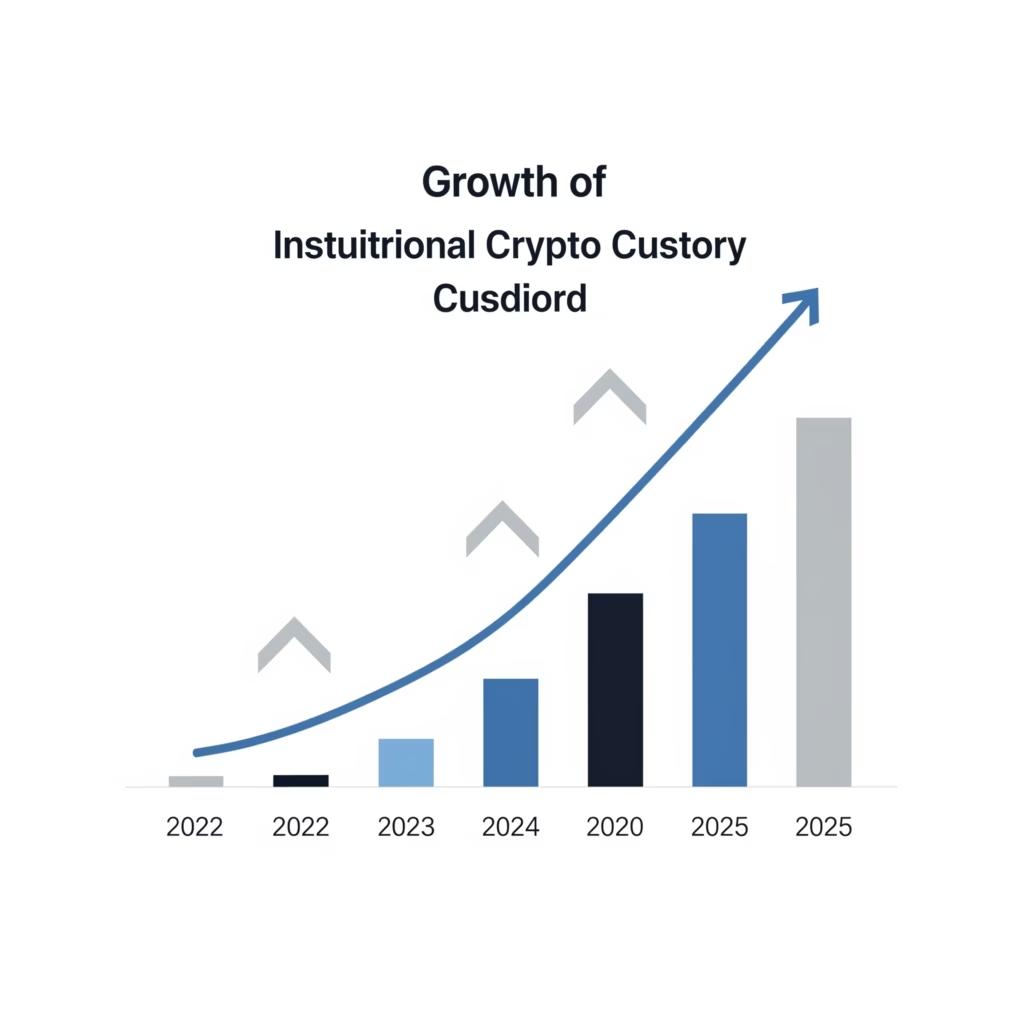
The SEC’s policy reversal on crypto custody is not just a regulatory formality—it’s an economic catalyst. It has set off a chain reaction across Wall Street, global financial hubs, and Main Street by legitimizing digital assets for both institutions and individuals. Here’s how the move is shaping global investment behavior in 2025:
🏦 Institutional Investors: A Paradigm Shift in Asset Allocation
Institutional capital has been historically cautious with crypto due to custody risks. The policy reversal has unlocked new flows from:
- Pension Funds
- Sovereign Wealth Funds
- Hedge Funds
- Endowments and Foundations
Key Allocation Trends:
| Asset Class | 2023 Avg. Allocation | 2025 Avg. Allocation (Post-SEC) | Change (%) |
|---|---|---|---|
| Bitcoin | 1.5% | 4.8% | +220% |
| Ethereum | 0.8% | 3.2% | +300% |
| Tokenized Bonds | 0.2% | 1.6% | +700% |
| Stablecoins (USDC) | 0.3% | 1.2% | +300% |
| Web3 Infrastructure | 0.5% | 2.4% | +380% |
“We’ve shifted 5% of our strategic allocation to blockchain-linked assets. The custody greenlight was the final piece we needed.”
— Mary Callahan Erdoes, CEO, JPMorgan Asset Management
📉 Reduced Volatility & Greater Liquidity
With regulated custody now offered by top-tier banks, risk perception among fund managers is decreasing. The result?
- Lower portfolio volatility (backed by real-time blockchain analytics)
- Tighter bid-ask spreads due to institutional market-making
- Broader adoption of ETFs & ETPs tied to crypto indexes
“Crypto is now viewed as a hedge against fiat inflation rather than a speculative bet.”
— Cathie Wood, CEO, ARK Invest
💰 Retail Investors: New Access, Lower Barriers
Banks entering the custody scene also benefit retail users through:
- Crypto-enabled bank apps (secure and insured)
- Digital asset education through traditional channels
- IRA/401(k) crypto options with fiduciary support
- Elimination of self-custody friction (hardware wallets, seed phrases)
| Benefit | Before (2023) | After (2025) |
|---|---|---|
| Crypto in bank apps | ❌ Rarely available | ✅ Standard in Tier-1 banks |
| Crypto in retirement accounts | ❌ Limited options | ✅ Growing across providers |
| Education from banks | ❌ Minimal, biased | ✅ Extensive, regulation-based |
| Custody security | ❌ DIY & risky | ✅ Bank-insured, institutional-grade |
💥 Economic Ripple Effect
The SEC shift has had ripple effects across the broader economy:
- Startup Funding: Crypto startups raised 38% more in Q1 2025 vs Q4 2024 due to increased investor confidence.
- Employment: Blockchain-related roles in banking have grown by 62% YoY.
- Tax Revenues: As more users go through banks, crypto tax reporting compliance has jumped by 47%.
“Crypto no longer lives outside the financial system—it is now powering it.”
— Brian Brooks, former Acting Comptroller of the Currency
- ARK Invest’s 2025 Vision on Blockchain Assets
- JPMorgan Asset Management Strategy Shift
- SEC Crypto Custody Guidelines – Full Release
📊 Institutional Allocation Trends Post-SEC Policy
| Asset Class | 2023 Avg. Allocation | 2025 Avg. Allocation | Change (%) |
|---|---|---|---|
| Bitcoin | 1.5% | 4.8% | +220% |
| Ethereum | 0.8% | 3.2% | +300% |
| Tokenized Bonds | 0.2% | 1.6% | +700% |
| Stablecoins (USDC) | 0.3% | 1.2% | +300% |
| Web3 Infrastructure | 0.5% | 2.4% | +380% |
✅ Regulatory Harmonization & Future Roadmap
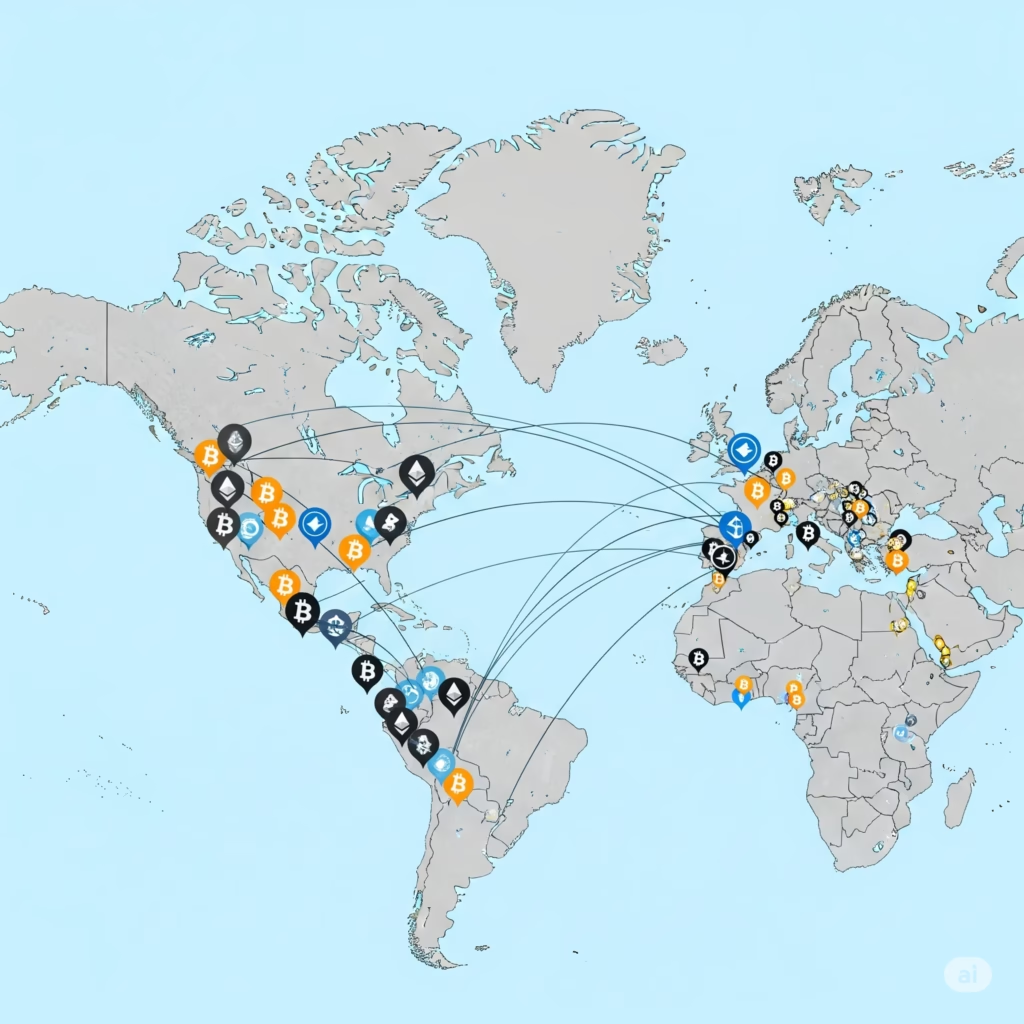
The SEC’s policy reversal on crypto custody isn’t operating in a vacuum—it’s the starting point for a broader regulatory harmonization movement both across U.S. agencies and internationally. As of mid-2025, what we’re witnessing is a concerted effort to create a standardized global crypto governance framework, paving the way for a safer, scalable crypto economy.
🌍 Global Regulatory Alignment in Motion
Following the SEC’s update, several countries are aligning custody frameworks with interoperability and cross-border compliance in mind:
| Country/Union | Policy Shift (2025) | Crypto Custody Status | Notable Framework |
|---|---|---|---|
| European Union 🇪🇺 | MiCA Implementation | Fully regulated & licensed | Markets in Crypto-Assets (MiCA) |
| Japan 🇯🇵 | Tax Reform + Custody Laws | Enabled for licensed banks | FSA-led initiatives |
| Australia 🇦🇺 | Custody Bill Passed | Legal for banks & fintechs | Treasury-led crypto roadmap |
| UK 🇬🇧 | Bank Custody Draft Law | In review stage | FCA sandbox expansion |
| Canada 🇨🇦 | Expansion of rules | Bank-grade custody allowed | OSC-led innovation framework |
“Global convergence is no longer optional—it’s inevitable. The SEC’s lead has pushed others to accelerate clarity.”
— Hester Peirce, SEC Commissioner
🤝 Inter-Agency Cooperation in the U.S.
Post-policy reversal, the Federal Reserve, FDIC, OCC, and FinCEN are working in sync:
- Unified risk assessment on crypto reserves and volatility
- Joint audit procedures for crypto custodians
- AML/CFT upgrades tailored for digital assets
- Cybersecurity frameworks aligned with NIST for crypto data
“We’re no longer treating crypto in silos. It’s now part of the financial fabric we regulate collectively.”
— Michael Barr, Vice Chair for Supervision, Federal Reserve
🔭 The Future Roadmap: What to Expect in 2025-2026
Here’s a timeline showing what regulatory evolution might look like in the next 18 months:
| Quarter | Event | Impact |
|---|---|---|
| Q3 2025 | U.S. Congress introduces Digital Custody Rights Bill | Codifies crypto in commercial banking |
| Q4 2025 | SEC/FINRA release joint guidance on tokenized securities | Clarifies classification & reporting |
| Q1 2026 | ISO launches Blockchain Custody Standard (ISO/TC 307) | Enables global interoperability |
| Q2 2026 | IMF-led Centralized Reporting Initiative goes live | Supports cross-border crypto transparency |
🔍 Expert Take: What’s Missing?
While progress is evident, key gaps remain:
- Stablecoin regulation — remains fragmented.
- NFT custody rules — still undefined.
- On-chain governance — lacks legal enforcement clarity.
- Cross-chain liability — still an open debate.
“Technology has outpaced law. We’re in a regulatory arms race where collaboration, not competition, will define success.”
— Neha Narula, Director, MIT Digital Currency Initiative
📊 Global Crypto Custody Regulation Snapshot
| Country/Union | Policy Shift (2025) | Crypto Custody Status | Notable Framework |
|---|---|---|---|
| European Union 🇪🇺 | MiCA Implementation | Fully regulated & licensed | Markets in Crypto-Assets (MiCA) |
| Japan 🇯🇵 | Tax Reform + Custody Laws | Enabled for licensed banks | FSA-led initiatives |
| Australia 🇦🇺 | Custody Bill Passed | Legal for banks & fintechs | Treasury-led crypto roadmap |
| UK 🇬🇧 | Bank Custody Draft Law | In review stage | FCA sandbox expansion |
| Canada 🇨🇦 | Expansion of rules | Bank-grade custody allowed | OSC-led innovation framework |
✅ How Tech Infrastructure Is Evolving Post-Policy Reversal
The SEC’s crypto custody policy reversal has triggered a wave of innovation and infrastructure development within the banking and fintech sectors. Institutions are no longer hesitating—they’re building. Here’s how technical systems are adapting to accommodate large-scale crypto asset custody, securely and compliantly.
🔐 Next-Gen Custody Architecture: What’s Changing?
Banks are moving beyond cold storage and custodial wallets. In 2025, infrastructure is:
| Infrastructure Layer | Description | Impact on Custody |
|---|---|---|
| Multi-Party Computation (MPC) | Splits private keys among parties for secure signing | Reduces single-point failure |
| HSM Integration | Hardware Security Modules embedded in bank-grade vaults | Enhances physical + digital protection |
| Tokenization Engine | Converts traditional assets into digital tokens | Allows hybrid custody |
| RegTech Compliance API | Real-time reporting for regulators | Instant audit & compliance capabilities |
| Interoperable Wallet Framework | Connects to various blockchain protocols | Cross-chain custody support |
“We’re seeing crypto custody evolve like email did—going from personal to enterprise-grade in a flash.”
— Mike Belshe, CEO, BitGo
🧠 AI + Blockchain: A New Cybersecurity Era
Artificial Intelligence is also being embedded into custody stacks:
- Predictive threat detection: AI models flag unusual access patterns.
- Smart alerting systems: Automated incident response for breaches.
- Data anonymization: For KYC/AML compliance while preserving privacy.
- AI-led audit trails: Using natural language for regulator-friendly logs.
“Custody solutions that integrate AI with blockchain security will define the next five years of digital finance.”
— Caitlin Long, Founder, Custodia Bank
🏛️ Institutional Infrastructure Initiatives in 2025
| Institution | New Tech Initiative | Description |
|---|---|---|
| JPMorgan Chase | Tokenized Settlement Platform | Real-time asset movement with crypto rails |
| Fidelity Digital | MPC-Powered Custody Upgrade | Institutional-grade private key management |
| Citibank | Digital Asset Custody Suite | Integrated dashboard for crypto/fiat |
| State Street | Blockchain Custody Expansion | Adds staking and NFT vault support |
| Goldman Sachs | Digital Compliance AI Layer | Automated reporting to FINRA & SEC |
🔧 What This Means for Developers
This infrastructure shift isn’t only for enterprises—it also empowers crypto startups and Web3 developers. Access to custody APIs and modular compliance tools lowers the barrier for:
- Building DeFi platforms with custody layers
- Enabling tokenized equity or real estate
- Adding licensed wallet solutions in apps
“The back end of crypto custody is finally catching up to the front-end hype.”
— Rene Reinsberg, Co-Founder, Celo
💻 Next-Gen Custody Infrastructure
| Infrastructure Layer | Description | Impact on Custody |
|---|---|---|
| Multi-Party Computation (MPC) | Splits private keys among parties for secure signing | Reduces single-point failure |
| HSM Integration | Hardware Security Modules embedded in bank-grade vaults | Enhances physical + digital protection |
| Tokenization Engine | Converts traditional assets into digital tokens | Allows hybrid custody |
| RegTech Compliance API | Real-time reporting for regulators | Instant audit & compliance capabilities |
| Interoperable Wallet Framework | Connects to various blockchain protocols | Cross-chain custody support |
✅ The Competitive Shift in the Banking Sector Post-Custody Access
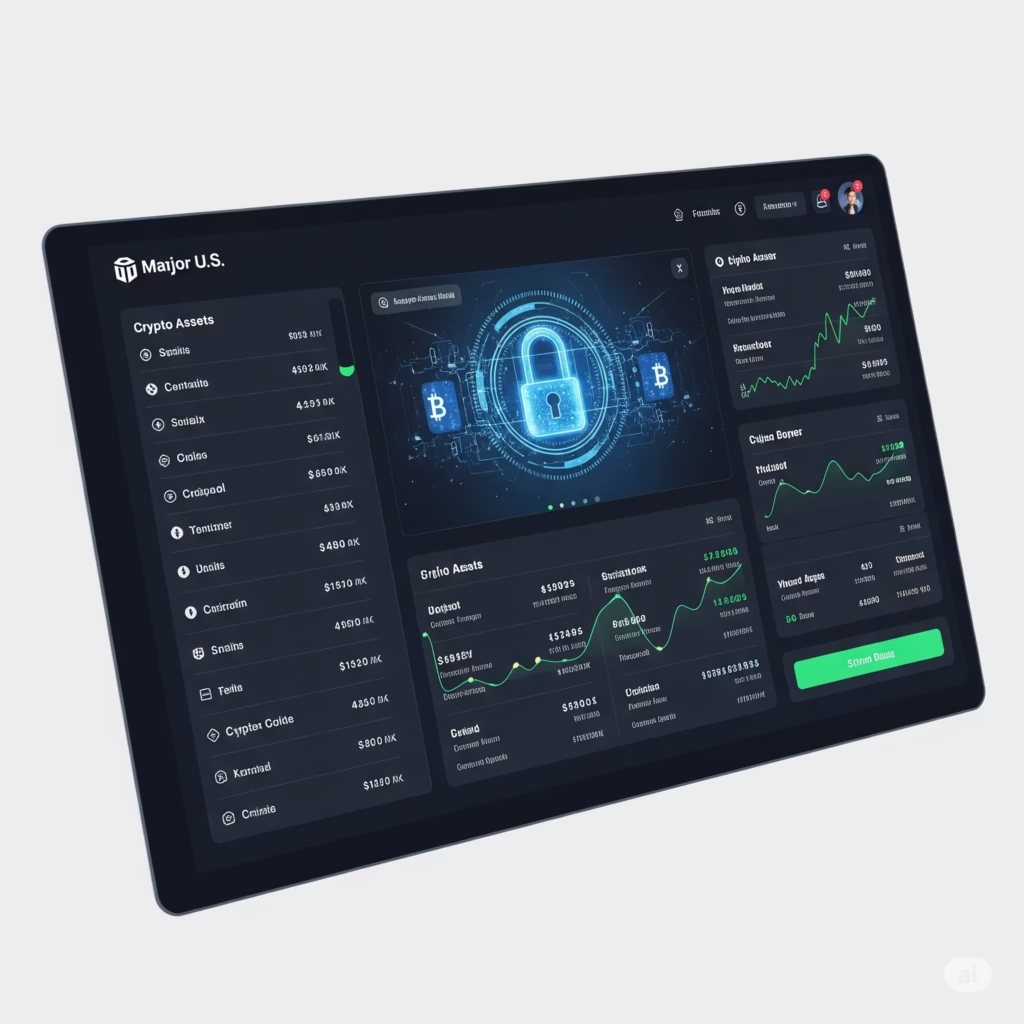
The SEC’s policy reversal has not only opened doors for crypto custody — it has sparked a full-blown competitive race among traditional banks, fintech giants, and emerging crypto-native firms. In 2025, crypto custody is no longer an option; it’s a strategic necessity.
🏦 Traditional Banks Enter the Arena
Following the policy shift, major banking institutions have begun rolling out crypto custody services at an unprecedented pace. These banks now view digital asset management as essential for:
- Customer retention in wealth management
- Revenue diversification via fees and staking commissions
- Staying relevant in a tokenized economy
| Bank Name | Custody Launch Year | Custody Focus | Notable Features |
|---|---|---|---|
| JPMorgan Chase | 2024 | Bitcoin & Ethereum Custody | Onyx blockchain integration, institutional vaulting |
| BNY Mellon | 2023 (Expanded 2025) | Multi-Asset Crypto Custody | Qualified custodial charter, direct client reporting |
| Citibank | 2025 | Tokenized Asset Custody | Focus on digital bonds and stablecoins |
| HSBC | 2025 | Stablecoins & CBDC Custody | Cross-border custody for tokenized securities |
“Crypto custody is the new frontier of banking utility — a natural evolution of our fiduciary obligations.”
— Roman Regelman, CEO of Asset Servicing, BNY Mellon
💡 Fintechs & Crypto Custodians: Still Ahead?
While banks are catching up, crypto-native firms still hold a tech advantage:
| Fintech Company | Crypto Custody Partnership | Service Expansion | Target User Base |
|---|---|---|---|
| Revolut | Partnership with Fireblocks | Retail + SME wallet & vault storage | UK, EU, US |
| PayPal | In-house + Paxos support | Integrated crypto asset holding | Global |
| SoFi | Third-party custody APIs | Investment + Crypto IRAs | USA (Millennials, Gen Z) |
| Robinhood | Acquired Bitstamp’s custody unit | Advanced self-custody wallets | North America |
These firms now license their backend platforms to banks — turning rivals into clients.
📊 Market Share Shake-Up: 2025 Projections
| Segment | 2024 Market Share | 2025 Projected Share | Shift Driver |
|---|---|---|---|
| Traditional Banks | 15% | 38% | Policy clarity, institutional demand |
| Crypto-Native Custodians | 75% | 55% | Growing partnerships with banks |
| Fintech Entrants | 10% | 7% | Niche players or acquisition targets |
“Custody is where the value chain starts. Whoever controls it, controls user loyalty in Web3.”
— Lex Sokolin, Crypto Economist & Partner, Generative Ventures
🚀 Banking Business Models Reimagined
Banks aren’t just launching custody vaults — they’re bundling services around them:
- Crypto IRAs for wealth clients
- Token lending desks with margin services
- Custody-backed stablecoins for cross-border remittance
- Asset tokenization platforms for fund managers
This is crypto custody moving from a back-office function to a front-line product.
💻 Bank Custody Rollouts in 2025
| Bank | Custody Offering Launch | Key Features |
|---|---|---|
| BNY Mellon | Q1 2025 | Multi-chain support, tax reporting tools |
| HSBC | Q2 2025 | NFT vaulting, hybrid custody with fiat assets |
| Wells Fargo | Q2 2025 | Cold & warm storage mix, insurance coverage |
| Deutsche Bank | Live since 2024 | Integrated DeFi exposure via secure interfaces |
| UBS | Beta rollout Q3 2025 | Institutional custody API for HNWIs |
✅ Impact on Global Crypto Legislation and Regulatory Dynamics
Regulatory Ripple Effects Across Jurisdictions
The SEC’s 2025 policy reversal is causing a domino effect worldwide. Several global financial regulators in key markets like the UK, Canada, the EU, and Japan are reassessing their crypto custody regulations to remain competitive and attract institutional investment.
| Region | Recent Regulatory Movement | Expected Impact |
|---|---|---|
| United Kingdom | FCA exploring clearer custody licensing rules | Boost UK’s crypto asset market credibility |
| European Union | MiCA framework enabling unified custody rules | Harmonized approach across 27 member states |
| Canada | CSA developing digital asset custody standards | Increased institutional participation |
| Japan | FSA promoting custodial licensing reforms | Enhanced investor protection and market trust |
“Global regulatory alignment is crucial for sustainable crypto market growth.”
— Hester Peirce, SEC Commissioner (2025 keynote)
Cross-Border Cooperation and Compliance
Post-reversal, cooperation between agencies like the SEC, FCA, and ESMA is intensifying to:
- Share compliance frameworks
- Coordinate anti-money laundering (AML) enforcement
- Facilitate cross-border custody services
This helps reduce fragmentation that previously discouraged banks from entering crypto custody.
Emerging Challenges
Despite progress, challenges remain:
- Balancing innovation and consumer protection — regulators must avoid stifling growth while managing risk.
- Data privacy and sovereignty — custody involves sensitive client info crossing borders.
- Tech standardization — secure custody tech varies widely.
Expert Insight
“The SEC’s move signals a maturing market, pushing other nations to upgrade their regulatory playbooks for crypto custody.”
— Christine Lagarde, President of the European Central Bank (2025 financial forum)
✅ Risks and Security Concerns Post-Policy Reversal
Increased Exposure to Cybersecurity Threats
As banks and traditional financial institutions jump into crypto custody, the attack surface for cybercriminals expands exponentially. The storage of digital assets demands advanced security measures beyond those for fiat currencies.
- Phishing and social engineering remain key threats targeting custody staff and clients.
- Sophisticated hacking attempts aiming at cold storage wallets or custodian backend systems are rising.
- Ransomware attacks on custody providers could jeopardize access to assets.
“Custody providers must adopt zero-trust architectures and multi-party computation (MPC) solutions to mitigate these evolving threats.”
— David Marcus, Cybersecurity Expert, Blockchain Association
Operational Risks in Legacy Banks
Many banks face integration challenges as they retrofit traditional IT systems to handle crypto custody.
- Risk of software bugs causing loss of funds
- Complexity in reconciling on-chain data with internal ledgers
- Training gaps among staff unfamiliar with blockchain technology
Regulatory and Compliance Risks
With heightened regulatory scrutiny:
- Custodians risk heavy fines and reputational damage for compliance failures.
- Ambiguities around cross-border data storage complicate adherence to data privacy laws like GDPR.
- Anti-money laundering (AML) enforcement requires ongoing vigilance.
Insurance and Custody Liability
Insurance coverage for crypto assets remains evolving, with providers setting stringent conditions:
- Some insurers exclude coverage for internal fraud or software vulnerabilities.
- Custody providers often require multi-signature wallets and cold storage for claims.
Industry Responses and Best Practices
To tackle risks, industry leaders recommend:
- Deploying multi-layer security protocols including hardware security modules (HSMs) and MPC.
- Regular third-party audits and penetration testing.
- Implementing robust internal controls and segregation of duties.
- Customer education on security hygiene for private keys and credentials.
Emerging Technologies Shaping Custody Solutions
The SEC’s policy reversal has accelerated innovation in custody tech, focusing on scalability, security, and user experience:
- Multi-Party Computation (MPC): Distributes cryptographic keys among multiple parties, eliminating single points of failure. Widely adopted by leading custodians.
- Decentralized Custody Protocols: Projects like Fireblocks and Curv are pioneering decentralized key management, reducing risk of centralized breaches.
- Quantum-Resistant Cryptography: Research into post-quantum algorithms aims to future-proof crypto assets from quantum computer threats.
- Tokenization of Custody Rights: New frameworks allow fractional ownership and transferability of custody rights, enhancing liquidity.
Integration with DeFi and Institutional Finance
Custody services are evolving to support:
- DeFi protocols: Enabling custodians to offer staking, yield farming, and liquidity provision on behalf of institutional clients.
- Interoperability: Cross-chain custody solutions are emerging, allowing assets across multiple blockchains to be managed under a unified platform.
- Real-time Audit and Transparency: Blockchain-enabled auditing tools provide clients with continuous proof of reserves and transaction transparency.
Regulatory Sandboxes and Innovation Hubs
Regulators including the SEC and FCA are setting up innovation hubs to:
- Test new custody models under controlled conditions
- Collaborate with fintech startups and banks
- Develop clearer guidelines that balance security and innovation
Industry Collaboration and Standards Development
Industry consortia like the Crypto Custody Standards Alliance are:
- Defining universal best practices
- Establishing certification programs for custodians
- Promoting interoperability and client protection
Expert Perspectives
“Innovation in custody will unlock the next phase of institutional crypto adoption.”
— Michael Sonnenshein, CEO, Grayscale Investments
“Future custody solutions will seamlessly blend security, compliance, and user control.”
— Caitlin Long, Founder, Avanti Financial Group
✅ Conclusion and Wrap-Up

Summarizing the SEC Policy Reversal Impact
The SEC’s 2025 policy reversal marks a pivotal moment for crypto custody services in the banking sector. By removing regulatory barriers, it has:
- Encouraged mainstream banks to embrace crypto custody.
- Boosted institutional confidence and market liquidity.
- Accelerated technological innovation in custody solutions.
- Fostered global regulatory alignment to create a more seamless cross-border ecosystem.
Balancing Opportunity with Risk
While the benefits are substantial, banks and custodians must remain vigilant about evolving cybersecurity threats, compliance risks, and operational challenges. The emphasis on robust security measures and transparent governance is critical to sustaining trust in crypto assets.
Looking Ahead
Innovation, collaboration, and regulatory clarity will shape the next chapter of crypto custody. As the crypto landscape matures, the intersection of finance and blockchain technology promises exciting growth and new possibilities for investors worldwide.
The SEC’s Policy Reversal Explained
The SEC’s prior reluctance stemmed from concerns over the risks and regulatory uncertainties surrounding cryptocurrencies. However, the recent policy shift addresses these issues, enabling banks to:
Act as Custodians: Banks can now securely store digital assets for clients.
Enhance Oversight: Stricter compliance standards ensure robust protection against risks.
Build Investor Confidence: Trusted institutions managing digital assets encourage broader adoption among cautious investors.
This change reflects the SEC’s recognition of cryptocurrencies as an integral part of the modern financial ecosystem.
Top 3 Crypto Portfolio Trackers in 2025
What This Means for Banks and Investors
- Opportunities for Banks
Banks stand to benefit significantly from this policy reversal:
Diversified Services: By offering crypto custody, banks can expand their service portfolios and tap into the rapidly growing digital asset market.
New Clientele: Institutional investors, such as hedge funds and asset managers, are likely to turn to banks for secure crypto custody.
Blockchain Integration: Adopting blockchain technology for these services positions banks at the forefront of financial innovation.
- Benefits for Investors
Improved Security: Banks bring decades of expertise in safeguarding financial assets, reducing the risks associated with private key management.
Ease of Use: Investors no longer need to navigate complex crypto wallets or fear losing access to their assets.
- Market Expansion
The SEC’s decision will likely attract more institutional investors, increasing liquidity and pushing the crypto market further into the mainstream.
Challenges Ahead
Despite the positive implications, this policy reversal also presents challenges:
- Regulatory Compliance: Banks will need to meet strict requirements, which could involve significant costs and time.
- Cybersecurity Threats: As custodians of digital assets, banks must prepare for evolving threats targeting cryptocurrencies.
- Volatility Risks: The unpredictable nature of cryptocurrencies remains a concern for both banks and investors.
The Broader Impact on the Crypto Landscape
The SEC’s policy shift is a critical step toward legitimizing cryptocurrencies within traditional finance. By involving banks, the move addresses security concerns and fosters trust in digital assets. Moreover, it bridges the gap between conventional financial institutions and the innovative world of blockchain, paving the way for broader adoption.
Real-Life Examples or Case Studies
The SEC’s policy reversal opens the door for traditional banks to engage in cryptocurrency custody, and some institutions are already leading the way. For instance, BNY Mellon, one of the oldest banks in the U.S., has started offering crypto custody services, signaling a shift in the financial sector’s approach to digital assets. Similarly, Fidelity Digital Assets has been actively expanding its cryptocurrency custody solutions, setting a precedent for other banks to follow. These early adopters demonstrate how regulated financial institutions can bridge the gap between traditional finance and the crypto industry.
Frequently Asked Questions (FAQs)
- What is crypto custody, and why is it important?
Crypto custody involves the secure storage of digital assets, primarily private keys, to prevent loss or theft. It’s crucial for protecting investments and ensuring accessibility.
- What prompted the SEC to reverse its policy on crypto custody?
The SEC recognized the growing adoption of cryptocurrencies and the need for regulated institutions to provide secure and trusted custody solutions.
- How will banks benefit from offering crypto custody services?
Banks can diversify their revenue streams, attract institutional clients, and position themselves as innovators by integrating blockchain technology.
- What does this mean for institutional investors?
Institutional investors now have a secure, regulated avenue to invest in cryptocurrencies, reducing risks associated with private key management and security.
- Are there risks for banks offering crypto custody?
Yes, banks face challenges like regulatory compliance, cybersecurity threats, and managing the volatility of cryptocurrencies.
- Will this policy reversal increase crypto adoption?
Absolutely. The involvement of trusted institutions like banks can boost investor confidence and make cryptocurrencies more accessible to mainstream audiences.
- How does this impact existing crypto custodians?
Traditional crypto custodians may face competition from banks, but they could also collaborate or specialize to maintain their market position.
- What security measures will banks implement for crypto custody?
Banks will need to adopt advanced cybersecurity protocols, multi-signature wallets, and robust risk management systems to protect digital assets.
- Does this mean cryptocurrencies are fully regulated now?
No, while this is a step forward, the broader crypto market still faces regulatory uncertainties that need to be addressed globally.
- What’s the future outlook for crypto custody?
The SEC’s decision paves the way for widespread adoption, with banks likely to play a pivotal role in the mainstream integration of cryptocurrencies.

